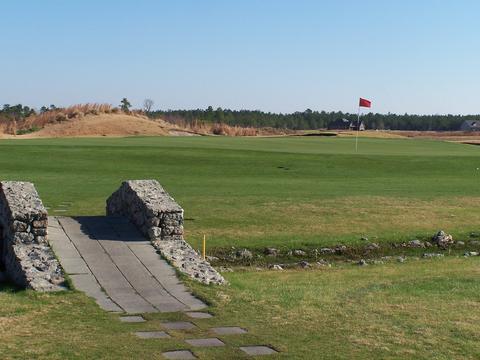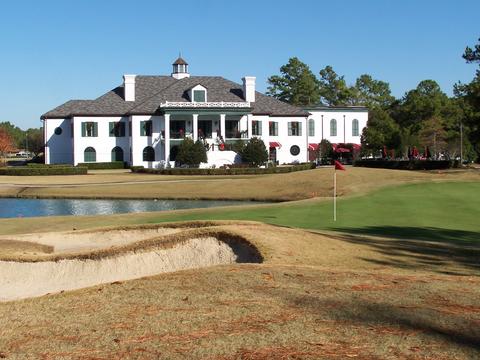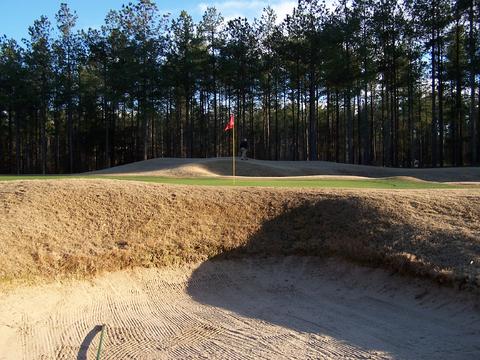A sample of homes on the course for sale in Wilmington, North Carolina
The following homes are in the $400,000 to $1 million range in golf course communities in Wilmington, NC (we have added one downtown Wilmington property for those inclined toward a little more history at their doorstep). We pulled these samples from the multiple listing services in the area; there are dozens more homes currently on the market at a wide range of prices. We can vouch for the quality of the golf course communities, having visited (and reviewed) those that are listed. If you are interested in any of these homes, or simply want more information about the best golfing communities in Wilmington, we will be pleased to put you in touch with a real estate agent we have personally qualified. There is no cost or obligation to you. Simply contact us (see the button at right), and we will email the agent's name and contact information to you. We will not furnish your name or contact information to the agent or anyone without your written approval.
Castle Bay
The Castle Bay golf course was designed and built by the community's developer, Randy Blanton, after an architect he had hired didn't give him what he wanted. What he wanted was a Scottish links course. I played it on a cold and windy day, and it sure seemed like a links course, although the high-tension wires and rows of tidy brick houses alongside some holes were a bit of a distraction. But if you can put your blinders on and keep your head down, the rolling terrain and heather framing do provide some echoes of Scotland. Because of the limited acreage for the homes, and their generally modest sizes, you can't spend much more than $500,000 for a house in Castle Bay. One new home with 4 bedrooms and 3 baths on 1/3 of an acre is currently on the market for $449,000. Membership in the semi-private club is just a few thousand dollars. Most other homes in the community are listed at under $500,000.
played it on a cold and windy day, and it sure seemed like a links course, although the high-tension wires and rows of tidy brick houses alongside some holes were a bit of a distraction. But if you can put your blinders on and keep your head down, the rolling terrain and heather framing do provide some echoes of Scotland. Because of the limited acreage for the homes, and their generally modest sizes, you can't spend much more than $500,000 for a house in Castle Bay. One new home with 4 bedrooms and 3 baths on 1/3 of an acre is currently on the market for $449,000. Membership in the semi-private club is just a few thousand dollars. Most other homes in the community are listed at under $500,000.
Porters Neck Plantation
 Porters Neck is a mature community with a terrific Tom Fazio golf course that was recently renovated at a cost to members in the seven figures. The club is in transition from semi-private to fully private, and greens frees for outsiders currently top $100. Membership initiation fees are $30,000. Porters Neck, which is about a 25-minute drive into the city, is a gated community lined with live oaks and nice landscaping touches. A home on the 7th green of the course features high-end kitchen appliances, custom cabinetry and extra touches, such as remote controlled window blinds. Dramatic, large windows provide nice views of the golf course. The home, with a Fazio Drive address, is available for $985,000.
Porters Neck is a mature community with a terrific Tom Fazio golf course that was recently renovated at a cost to members in the seven figures. The club is in transition from semi-private to fully private, and greens frees for outsiders currently top $100. Membership initiation fees are $30,000. Porters Neck, which is about a 25-minute drive into the city, is a gated community lined with live oaks and nice landscaping touches. A home on the 7th green of the course features high-end kitchen appliances, custom cabinetry and extra touches, such as remote controlled window blinds. Dramatic, large windows provide nice views of the golf course. The home, with a Fazio Drive address, is available for $985,000.
Landfall
Landfall, which sports two excellent courses, one by Dye and one by Nicklaus (27 holes), is conveniently located just eight miles from the city of Wilmington. Although we found the folks at the golf course a little snooty - they declined to let us play and review the course initially - our Wilmington real estate agent's friend who snuck us on could not have been nicer. A home on Arboretum drive that was built in 1995 on more than a half acre is currently listed at $733,500. Many other homes priced lower and higher are available in Landfall, and one huge house with killer views of the ocean is currently on the market for more than $7 million. Membership in the two courses, whose clubhouses are about a mile apart, is $55,000. We played the Nicklaus course on a cold, windy day and found it difficult. The Dye course is supposed to be just as challenging, but with a variety of tees on both tracks, you can play to your comfort level.
Downtown Wilmington
The Wilmington area offers some nice daily fee courses for those who either don't play enough golf to justify private club membership or would prefer a less restrictive arrangement. Wilmington's own municipal golf course, for example, is a Donald Ross design. The Wilmington Historic District is emerging quite nicely - we stayed at a bed and breakfast there a year ago - and would be an interesting alternative for those who prefer older homes with character to newer construction inside a community. And the costs per square foot downtown are certainly competitive: One particular Victorian on North 7th Street for $699,900 was built 100 years ago and features six bedrooms and six baths. The river, restaurants and shops are a short walk away.
Our complete, nine-page review of the top Wilmington golfing communities is available free with a $39 annual subscription to the HomeOnTheCourse community guide, published six times a year. Each issue of HomeOnTheCourse includes our objective, unbiased comments about the quality of golf and living in the southern U.S.'s top golfing communities, as well as some communities you may not know but should. For more information, go to HomeOnTheCourse.com.

























